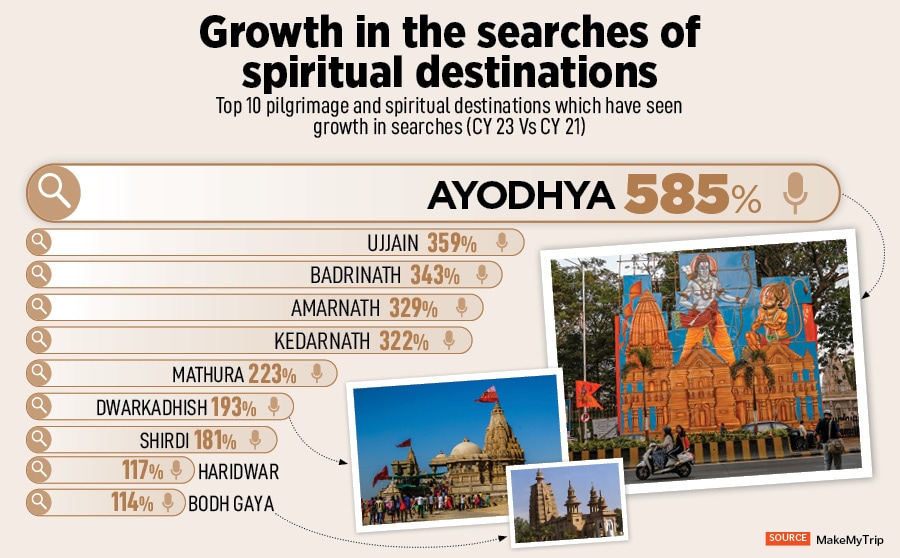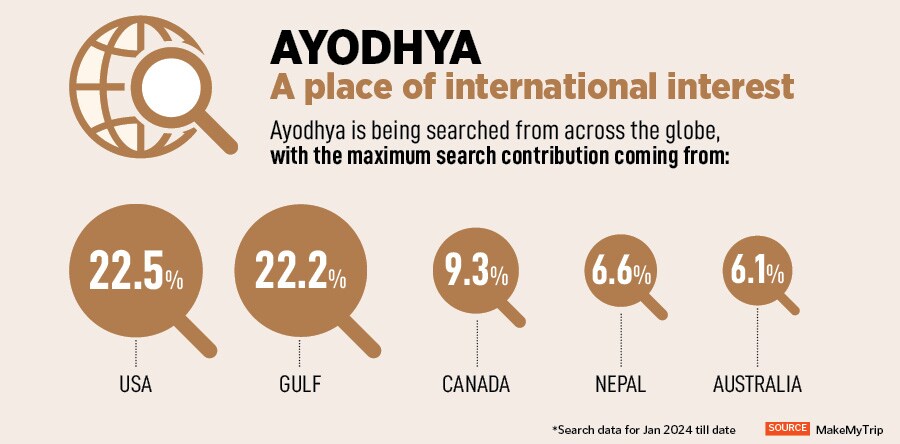Next stop: The land of God
With the inauguration of the Ram Temple in Ayodhya on January 22, the country is seeing a rise in spiritual tourism. According to experts, this phenomenon will see further growth as more and more trav


“You can feel something divine even in the air in Ayodhya. The whole city looks and feels like the era of Lord Ram," says 41-year-old Vidha Lal who recently came back from her visit to Ayodhya, a small town of about 30 lakh people, on the banks of Sarayu river, in Uttar Pradesh. Lal, a professional Kathak exponent, whose visit to the spiritual town was primarily to perform at one of the many pre-inaugural events happening in Ayodhya, says that her desire to witness the preparation of welcoming Lord Ram was fulfilled, thanks to an invitation for a dance performance by the government.
As the temple inauguration nears, over 45 lakh visitors are planning to visit Ayodhya in the coming days. Leading up to the inauguration, Ayodhya"s hotels are fully booked, enabling them to leverage increased pricing. Occupancy rates have risen 80 to 100 percent, resulting in substantial price hikes, reaching up to Rs 70,000/night in select hotels, according to travel agency company EaseMyTrip. Not just in Ayodhya, spiritual tourism in India for destinations such as Puri, Amritsar, Varanasi, etc. has seen a significant boost. According to a report by Booking.com, 70 percent of Indian travellers stated that they were seeking spiritual and mindfulness getaways to recentre the mind.
According to PP Khanna, board member of Federation of Associations in Indian Tourism & Hospitality (FAITH), domestic tourism majorly consists of pilgrim tourists which is approximately 60 percent of the total domestic tourists travelling across the country. “Spiritual tourism is growing tremendously and most of the pilgrim centres are receiving moderate to heavy footfalls of pilgrim tourists," says Khanna who believes that Ayodhya will become a top draw for NRIs living abroad, and will eventually become part of tour itineraries of foreign travellers. 
Travel portals such as MakeMyTrip, EaseMyTrip, and Cleartrip are seeing a spike in travel bookings for religious centres such as Bhubaneswar, Tirupati, Dehradun, and Trivandrum, among others. According to Prahlad Krishnamurthi, chief business officer, Cleartrip, the growth of spiritual tourism as a segment has been noteworthy, particularly post-Covid, compared to the pre-Covid period, with a significant increase of 62 percent in bookings. “There has been a remarkable 1.6x spike in segments in places renowned for spiritual tourism."
Ayushman Mishra, a 24-year-old professional based in Delhi, has been in Ayodhya for a week now. He describes the atmosphere of the city to be “jubilant". His inspiration to visit the holy town right now stems from his childhood. “My roots in Kushinagar, UP, and the stories of the Ayodhya movement of 1992, which I heard growing up, always intrigued me. The city’s proximity during my travels and its historical significance have long fascinated me. The announcement of the new temple was an opportunity I couldn’t miss," says Mishra who is also taking part in one of the many yagyas taking place in the city.
According to data by travel company MakeMyTrip, there has been a 97 percent growth in searches for spiritual destinations on the platform in the last two years, and the searches for Ayodhya from India increased by more than 1,800 percent since the inauguration announcement, with the peak searches on December 30, which was when the Ayodhya airport was inaugurated.
According to data released by the Ministry of Tourism in March 2023, places of religious tourism earned Rs 1,34,543 crore in 2022, up from Rs 65,070 crore in 2021. Going by this data, it can be assumed that spiritual/ religious tourism is a significant player in India’s travel recovery post pandemic. In 2014-15, the government launched the ‘Pilgrimage Rejuvenation And Spiritual Augmentation Drive’ (PRASAD). According to the ministry of tourism, this scheme focuses on developing and identifying pilgrimage sites across India for enriching the religious tourism experience. It aims to integrate pilgrimage destinations in a prioritised, planned and sustainable manner to provide a complete religious tourism experience. When it was launched, the government identified 41 religious sites from 25 states for development in the country, under the PRASAD Scheme. Some of the sites include Amaravati and Srisailam (Andhra Pradesh), Patna and Gaya (Bihar), Dwarka and Somnath (Gujarat), Gurudwara Nada Sahib, Panchkula (Haryana), Chamundeshwari Devi, Mysuru (Karnataka), Guruvayoor, St Thomas International Shrine (Malayattoor), Trimbakeshwar (Maharashtra), Puri (Odisha), Amritsar (Punjab), Kanchipuram and Vellankani (Tamil Nadu), Tripura Sundari (Tripura), Varanasi and Mathura (Uttar Pradesh), and Badrinath, Kedarnath, Gangotri and Yamunotri (Uttarakhand). Some projects such as Kashi Vishwanath, Somnath, Kedarnath and Mahakaleshwar Jyotirlinga Temples, among scores of others, have been successfully completed in the last decade, under the scheme. 
The pandemic has changed traveller perceptions and there has been a shift in consumer behaviour. While spiritual tourism was once associated with the senior citizen segment, over the past two years, there has been a significant uptick in demand from multigenerational families, couples/honeymooners, groups of friends, millennials and Gen Z as well, according to travel company SOTC Travel.
Moreover, the demand for visitors’ spiritual journeys is no longer restricted to traditional pilgrimages but a combination of spiritual breaks with unique local experiences and outdoor adventures like white-water rafting and night trekking in Vaishno Devi, bungee jumping in Rishikesh, boating on the Ganga river, visiting a heritage crafts village in Puri or learning a local art like Kalayaripayattu in Kerala. According to SOTC, hotel occupancy in these destinations is at 100 percent on weekends and holy dates, while on an average occupancy levels stand at 60-80 percent.
“Spiritual tourism has evolved as a concept and is significantly contributing to the overall revival of India’s tourism industry. With the recent announcement on the inauguration of the Ram temple in Ayodhya, our demand trends indicate increased interest for the destination from customers across segments with an uptick of 150 percent. We anticipate this significant demand to accelerate growth of spiritual tourism in the country," says Daniel D’Souza, president & country head - holidays, SOTC Travel.
Vidha Lal’s description of Ayodhya is that the town atmosphere is that of a month-long festival. Many stages have been set up around the temple for various performances by artistes from all over India. Electric autos have been assigned for the smooth transport of visitors and artistes. Help desks and guides can be found at various places around the area. Even a tent city has been built near the temple for people to stay. “Everywhere there were Ram bhajans playing and orange flags beautifully brightened the area. It was very well maintained. The police and security personnel were very vigilant. We didn"t feel unsafe even for a second," says Lal.
In light of the new-found interest among tourists to visit Ayodhya, hotels and hospitality chains are inaugurating new places to stay for the visitors. On January 17, budget hospitality chain Oyo announced that it will open 65 hotels and homestays in Ayodhya for pilgrims. Recently the Radisson Hotel Group announced the inauguration of its newest hotel in Ayodhya. "We are pleased to have an early mover"s advantage with the opening of our newest hotel in the sacred city of Ayodhya. With its rich cultural heritage and historical landmarks, Ayodhya holds a special place in the heart of our country," said KB Kachru, chairman emeritus and principal advisor, South Asia, Radisson Hotel Group, in a press release.
According to Nishant Pitti, CEO of EaseMyTrip, Ayodhya is undergoing significant infrastructural growth, planning for 73 new properties, including 40 currently under construction. “The inauguration of the Ram Mandir is anticipated to bolster tourism in Uttar Pradesh, stimulating travel to neighbouring cities such as Faizabad, Lucknow, Varanasi, and Prayagraj from Ayodhya," says Pitti. 
Whereas on one hand Ayodhya is welcoming tourists and devotees, there is also a lot more coming into the city. For example, a 108-foot-long incense stick, a 2,100-kg bell, gold footwear, a clock that simultaneously denotes time in eight countries are some of the special gifts sent for the Ram temple in Ayodhya ahead of the consecration ceremony from various places across India. Not just India, neighbouring countries such as Nepal and Sri Lanka, which are of great significance in the Ramayana, have sent various gifts to Ayodhya for the ceremony. Prior to the inauguration of the Ram temple, the holy town of Ayodhya has witnessed a Rs 85,000 crore investment boost. The inauguration will be attended by Prime Minister Narendra Modi, business tycoons, politicians, and celebrities from diverse fields. Some of the invitees include Virat Kohli, MS Dhoni, Alia Bhatt and Ranbir Kapoor, among others.
Mishra says that the vibe in Ayodhya currently is “electrifying". The anticipation of welcoming Lord Ram into the new temple has energised the entire city. The festive decorations, the influx of visitors from around the world, and the soaring hotel prices all indicate the city’s readiness for this historic event. Mishra plans to stay in Ayodhya till January 23, and leave only after a special darshan of the temple which is said to be open to the public from January 24. “This opportunity to witness and participate in such a significant event is something I cherish deeply," he says.
First Published: Jan 19, 2024, 12:29
Subscribe Now